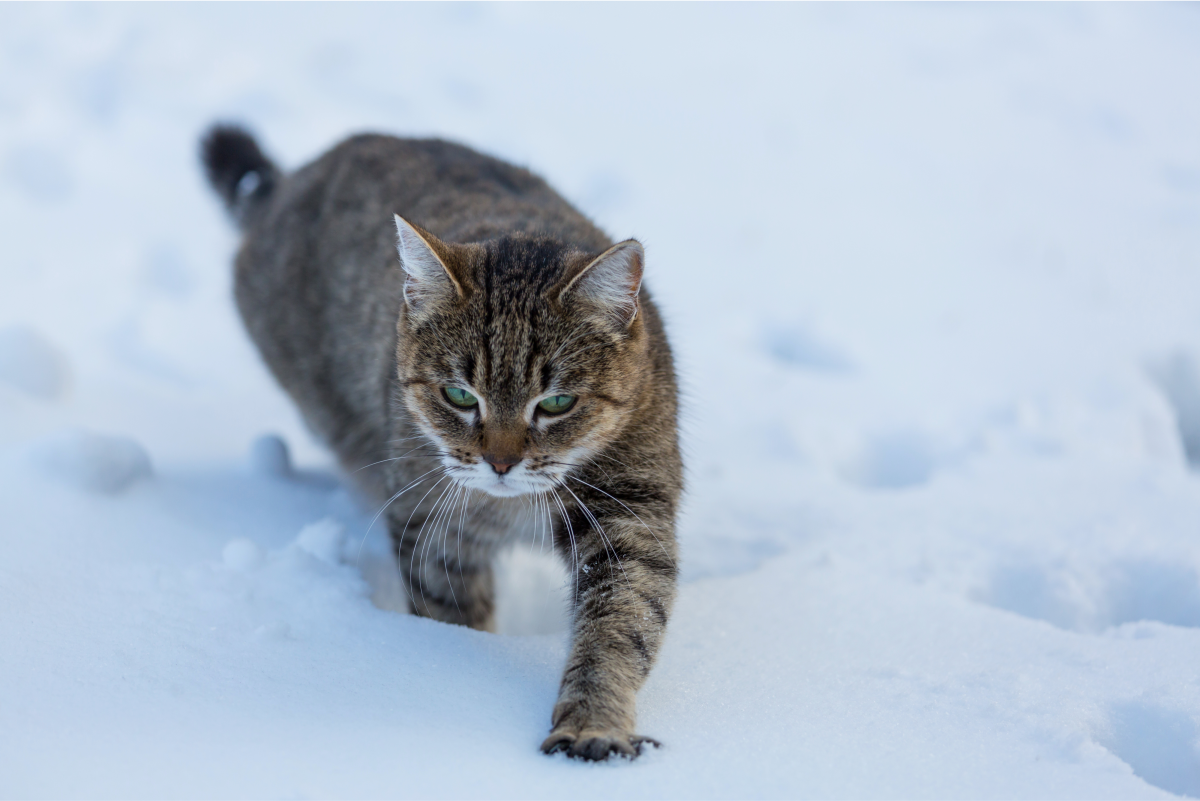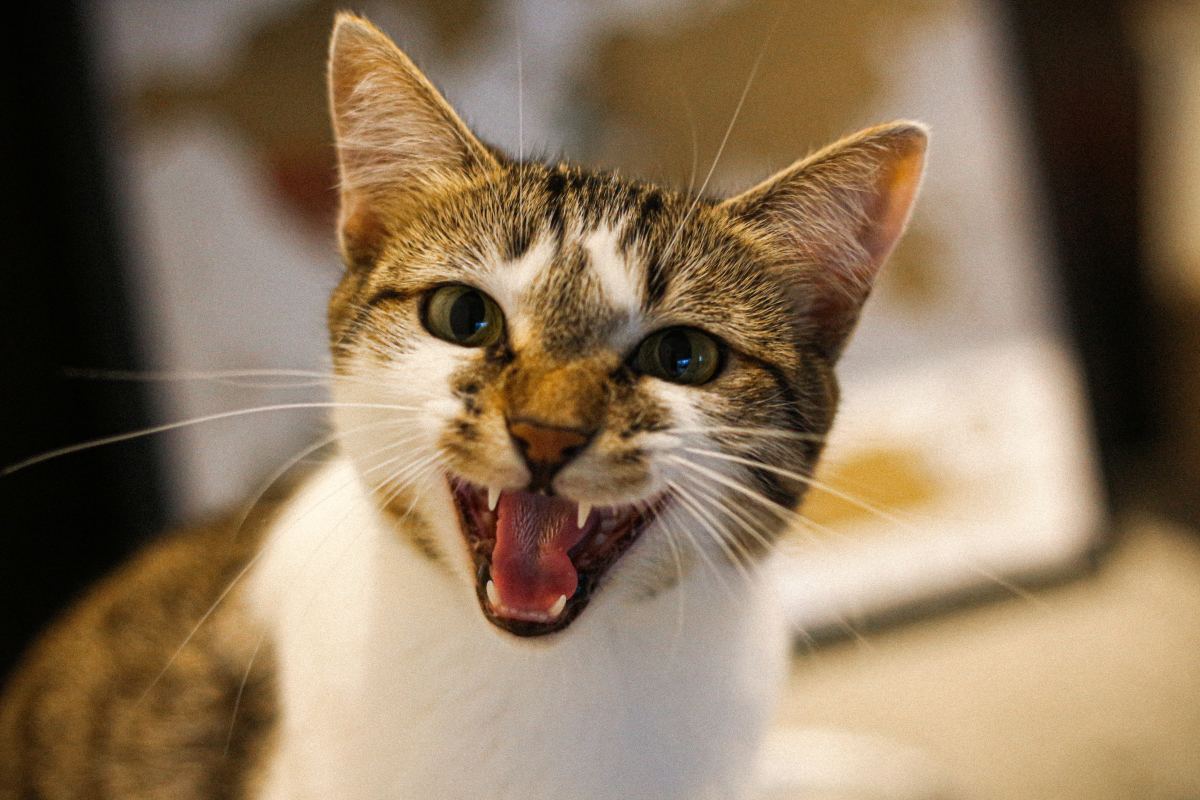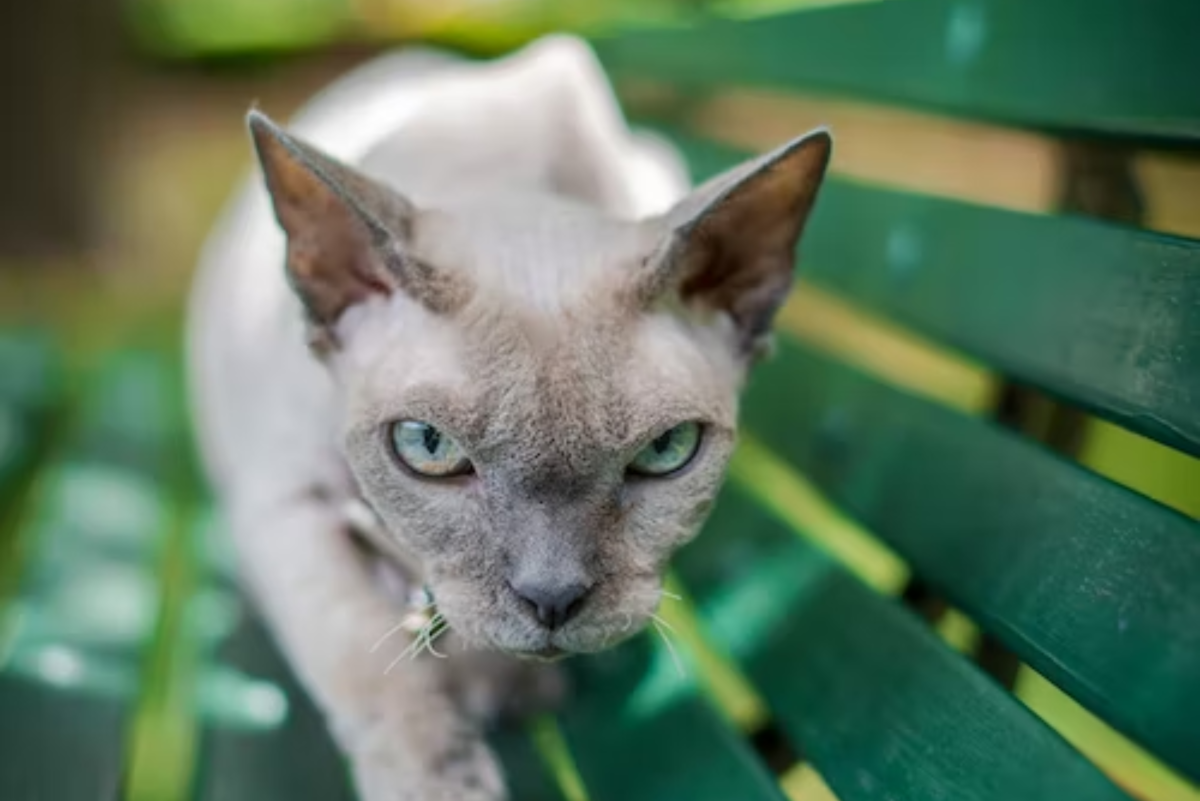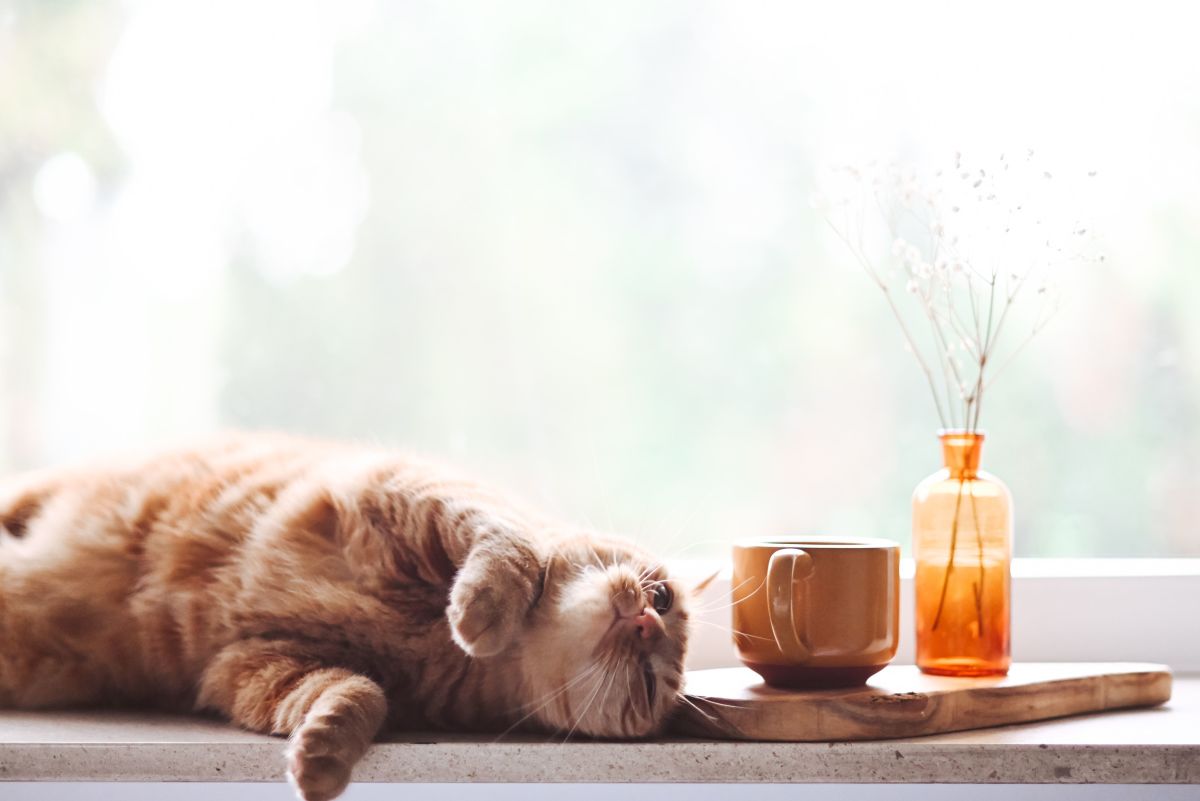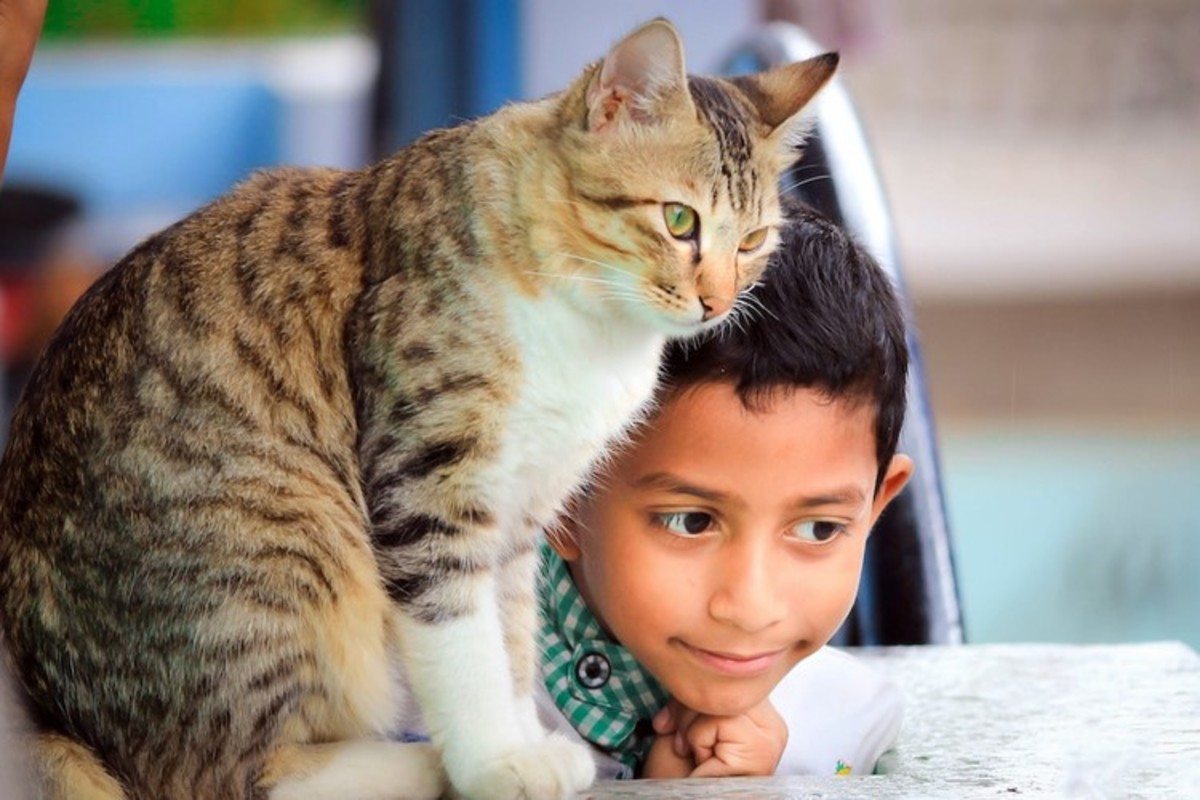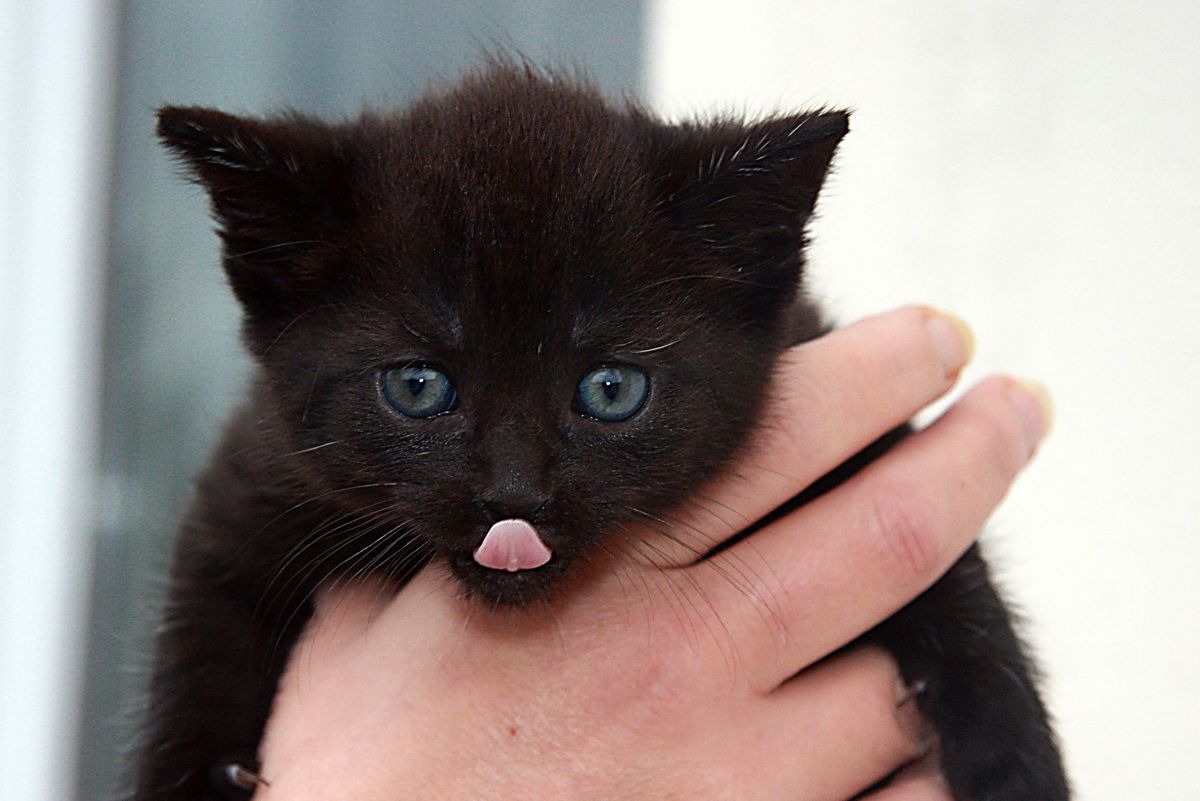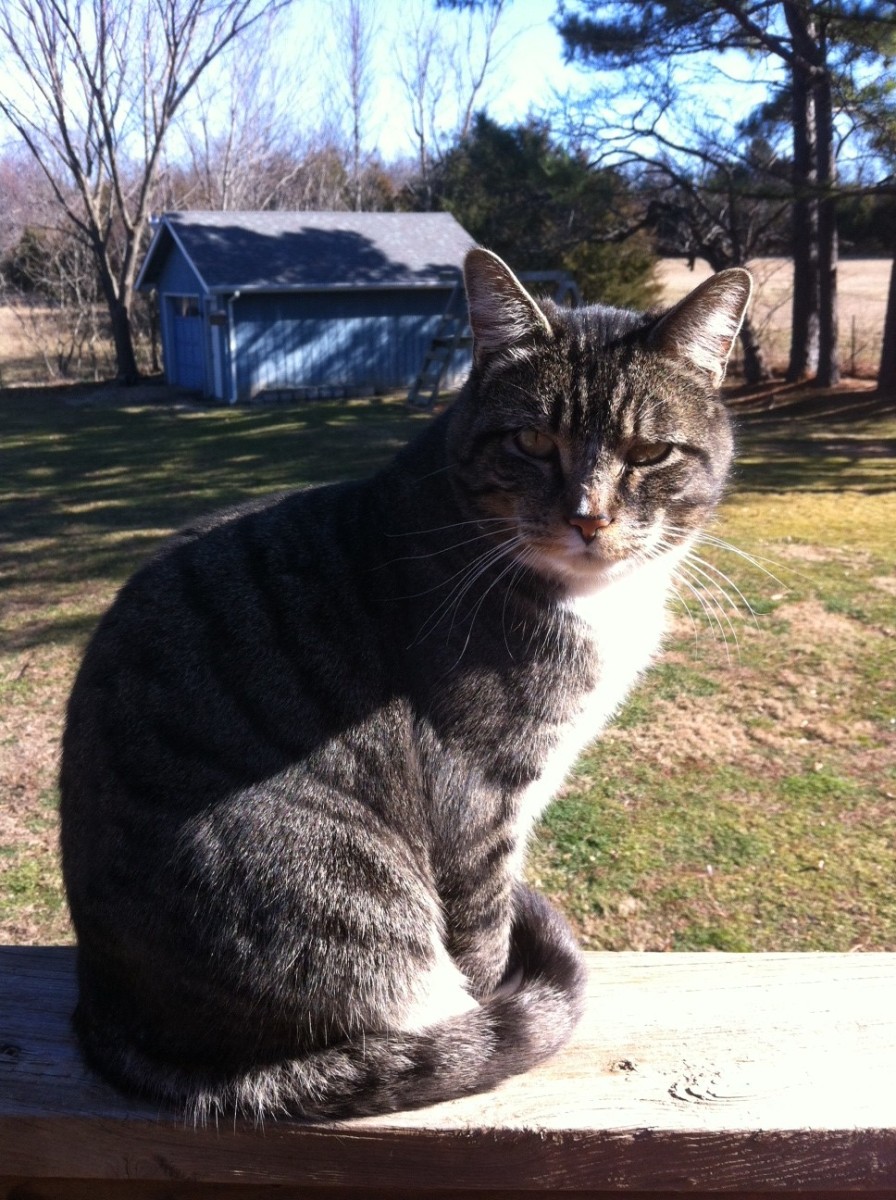- HubPages»
- Pets and Animals»
- Cats & Cat Breeds»
- Cat Behavior
Animal's Philosopy
Hayy cat I love you

About Cats
The cat is similar in anatomy to the other felid species, has a strong flexible body, quick reflexes, sharp teeth and retractable claws adapted to killing small prey. Its night vision and sense of smell are well developed. Cat communication includes vocalizations like meowing, purring, trilling, hissing, growling and grunting as well as cat-specific body language. It is a solitary hunter, but a social species. It can hear sounds too faint or too high in frequency for human ears, such as those made by mice and other small mammals. It is a predator that is most active at dawn and dusk. It secretes and perceives pheromones.
The cat is a small carnivorous mammal. It is the only domesticated species in the family Felidae and often referred to as the domestic cat to distinguish it from wild members of the family. The cat is either a house cat, a farm cat or a feral cat; latter ranges freely and avoids human contact.
- Lifespan: 2 – 16 years (In the wild)
- Scientific name: Felis catus
- Mass: 3.6 – 4.5 kg (Adult)
- Gestation period: 58 – 67 days
- Height: 23 – 25 cm
- Daily sleep: 12 – 16 hours (cats is lucky)
- Cats Breeds
- Abyssinian
- Aegean
- American Curl
- American Bobtail
- American Short hair
- American Wirehair
- Aphrodite Giant Cyprus
- Arabian Mau
- Australian Mist Australia
- Australian Mist
- Asian
- Asian Semi-longhair
- Balinese
- Bambino
- Birman
- Bombay
- Brazilian Short hair
- British longhair
- British Semi-longhair
- British Short hair
- British Longhair
- Burmese
- Burmilla
- California Spangled
- Chantilly-Tiffany
- Chartreux
- Chausie France Hybrid:
- Color-point Short hair
- Cornish Rex
- Manx Longhair;
- Devon Rex
- Chinese Li Hua China
- Dwelf
- Domestic Shorthair
- Domestic Longhair
- European Short hair
- Fold ex
- German Rex
- Havana Brown
- Highlander
- Javanese or Colorpoint Longhair
- Karelian Bobtail
- Khao Manee
- Korat Thailand
- Korean Bobtail Korea
- Korn Ja Thailand
- LaPerm
- Lykoi Lykoi
- Maine Coon
- Nebelung
- Napoleon
- Norwegian Forest Cat
- Ocicat
- Persian (modern)
- Persian (traditional)
- Peterbald
- Liebling (obsolete)
- Ragamuffin
- Ragdoll
- Russian Blue
- Russian White, Black, and Tabby
- Scottish Fold
- Serengeti
- Serrade Petit
- Siamese
- Siberian Forest Cat;
- Suphalak
- Traditional, Classic, or Old-style Siamese;
- Wichien Maat
- Thai
- Thai Lilac
- Tonkinese
- Toyger Toyger
And many more breeds of cats in tha world but I am write some cats breeds.
Scientific Benefits of Being a Cat Owner
- OWNING A CAT IS BETTER FOR THE ENVIRONMENT
If you're worried about your carbon footprint, it’s better to own a cat than a dog. A 2009 study found that the resources needed to feed a dog over the course of its life create the same eco-footprint as that of a Land Cruiser. Meanwhile, cats—which eat less in general and are more likely to eat fish than corn- or beef-flavored products—only have the approximate carbon footprint of a small hatchback.
2. THEY'LL HELP YOU COPE ..
Losing a loved one is incredibly painful, but one of the best ways of coping is to own a pet. Cats have been shown to help people get over their loss more quickly, and show less physical symptoms of pain, like crying. Despite the fact that they are only animals, cats serve as a social support during difficult times. People in mourning report talking to their pet to work out their feelings, since it is often easier to talk to something that won’t respond and can’t judge than to another human being.
3. ... AND FIND A SIGNIFICANT OTHER.
If you’re a single guy and you can’t seem to get a date, get a cat! A British poll found that 82 percent of women agreed they are more attracted to men who like animals. And while having a dog will do wonders for your dating life, a whopping 90 percent of single women said that men who own a cat are “nicer” than other guys. Listing that you own a cat on your dating profile could do wonders for the number of responses you get—but remember, a cat is for life, not just until you find a partner.
4. CAT OWNERS ARE SMART.
A 2010 survey of British pet owners by the University of Bristol found that people who owned cats were more likely to have college degrees than their dog loving counterparts. In 2014, a researcher in Wisconsin surveyed 600 college students and found that cat owners were actually more intelligent as well. (But it's probably not the cat itself making the owner smarter: The researchers conducting the Bristol survey said that smarter people tend to work longer hours, and since cats require less attention than dogs, they are a better choice for the busy intellectual.)
5. YOU'LL HAVE A HEALTHIER HEART.
Owning any pet is good for your heart. Cats in particular lower your stress level—possibly since they don’t require as much effort as dogs—and lower the amount of anxiety in your life. Petting a cat has a positive calming effect. One study found that over a 10-year period cat owners were 30 percent less likely to die of a heart attack or stroke than non-cat owners (although this might just be because cat owners are more relaxed and have lower stress in general).
6. THEY FULFILL YOUR NEED FOR COMPANIONSHIP.
The stereotype that dogs are more affectionate than cats is just that: a stereotype. In fact, it turns out that cats can be just as good of companions as dogs, especially for women. An Austrian study conducted in 2003 found that having a cat in the house is the emotional equivalent of having a romantic partner. As well as initiating contact much of the time, studies have shown cats will remember kindness shown to them and return the favor later.
But cats really do have the upper hand in these relationships. After thousands of years of domestication, cats have learned how to make a half purr/half howl noise that sounds remarkably like a human baby’s cry. And since our brains are programmed to respond to our children’s distress, it is almost impossible to ignore what a cat wants when it demands it like that.
7. THEY CAN TELL YOU (AND OTHERS!) A LOT ABOUT YOUR PERSONALITY.
Your choice of pet reveals something about your personality. While dog lovers tend to be the life of the party, cat owners are quieter and more introverted. However, they score very highly when it comes to how trustworthy they are and how much they trust other people. Cat owners are also less manipulative and more modest.
8. YOU'LL SLEEP BETTER.
Several studies and polls in the UK have found that people (especially women) prefer to sleep with their cats than with their partners, and they even report sleeping better with a cat than with a human. A recent study from the Mayo Clinic Center for Sleep Medicine indicates that they might be on to something: 41 percent of the people in that study indicated that they slept better because of their pet, while only 20 percent said that it led to disturbances.
9. CAT OWNERSHIP MEANS FEWER ALLERGIES.
Sadly, it’s too late for you, but if you have a child on the way, it might be time to get a cat. In 2002, the National Institutes of Health released a study that found children under a year old who were exposed to a cat were less likely to develop allergies—and not just pet allergies. According to Marshall Plaut, M.D., chief of the allergic mechanisms section at the National Institute of Allergy and Infectious Diseases, "high pet exposure early in life appears to protect against not only pet allergy but also other types of common allergies, such as allergy to dust mites, ragweed, and grass." And while the cat parasite Toxoplasma gondii is a threat to young children, experts say that by changing your cat’s litter box every day and keeping the animal indoors, you should be safe and allergy free!
10. THEY CAN QUITE LITERALLY SAVE YOUR LIFE.
Cats have a reputation of being aloof and not caring about their humans, but they have saved countless lives over the years. One cat in the United Kingdom warns her human when he’s about to have an epileptic seizure, while a cat in Montana woke up its two humans when a gas pipe started leaking. Firefighters told the couple that the house could easily have exploded if not for cat’s intervention.
How Often Should You Feed Your Cat?
The amount and frequency of meals depends on your cat's age, health and preference.
Check the pet food aisle at your local supermarket, and you'll find dozens of varieties of food to entice your cat. Feed your cat too little or the wrong kind of food, and he won't maintain good health. Feed him too much, and he'll get fat. But you can help get your cat off on the right paw by establishing regular feeding routines. Although the food you feed your cat should be complete and balanced, the simple answer to how often you should feed him is that there isn't a simple answer.
- Age Makes a Difference
Kittens require more food per pound of body weight to support their growth than do adult cats, and therefore should be fed more often throughout the day. "Growing kittens up to six months of age may require three meals a day," says Francis Kallfelz, DVM, Ph.D., board certified by the American College of Veterinary Nutrition and James Law professor of nutrition at Cornell University College of Veterinary Medicine. "From age six months to maturity, most cats will do well when fed two times a day."
Once the cat becomes an adult, at about one year, feeding once or twice a day is appropriate in most cases. Senior cats, age seven and above, should maintain the same feeding regimen. "Once cats reach adulthood, once a day feeding is fine as long as they are healthy and have no disease problems suggesting a reason to feed differently," says Dr. Kallfelz.
- The Health of Your Cat Matters
If your cat suffers from a health problem such as diabetes, you may need to feed him based on whenever he is administered insulin, depending on the type.
When a cat ages, his teeth may go bad, or he may develop gum disease that may make it difficult to chew dry food. "If they get to that point, then offer them canned food or dry in a finer nugget size
- A Best Type of Food?
Many cat owners feed only dry food to their felines. "Dry food is fine as long as it is complete and balanced," says Dr. Kallfelz. Dry food may be less expensive than canned cat food and may stay fresher longer. Cats that eat only dry food need to be provided with lots of fresh water, especially if they are prone to developing urinary tract blockages. For all cats, constant availability of fresh, clean water is important.
Canned cat food is typically about 70 to 80 percent water, and can be fed in addition to or instead of dry. Some cats may find canned food more palatable. These cats may consume too much if they are allowed free access to food. Of course, this may occur with dry food as well. "Food with average palatability may be preferable
Super-sizing food portions is not just a problem for people. Since the feeding instructions on pet food labels are based on the needs of the average cat, you may be feeding more than necessary if your cat's needs are lower than average. If you feed your cat dry food, you may provide it to him at specific mealtimes in measured quantities. Dry food can also be supplemented with a small amount of canned food to make meals more appealing.
"There's no problem mixing the two types of food," says Dr. Kallfelz. "Just make sure the calories are what your cat needs and not more."
Free feeding dry food is acceptable for the cat who exercises self-control, but some cats like to snack, and for them, free feeding can add up to extra pounds. "If a cat can maintain his weight, free choice feeding is okay," says Dr. Kallfelz. Even dry food left out for your cat to free feed needs to be fresh, so be sure to provide new food each day. If free feeding doesn't work, you need to control how much they eat. "Several small meals may make them feel less hungry," says Dr. Kallfelz. "But one is okay nutritionally."
And here's a useful hint: If you have a finicky cat, switching foods occasionally may help keep from him becoming hooked on only one diet.
- Consider Your Schedule
How often you feed your cat may depend on your schedule as well. Mornings may be hectic as you get the kids off to school and yourself off to work. Under those circumstances, feeding your cat may be easier in the evening when it's quieter and less busy. If you are running around a lot in the evening, feed your cat in the morning before everyone else is up. Find a schedule that works for you and your cat - and then keep it consistent.
In a multicat household, not all cats automatically come when called for dinner, potentially making it difficult for some to get food unless it is left out all the time. And other cats may eat too much when food is always available. "You just need to come up with a plan
How to understand and influence your cat's behavior ?
- Cat Hunting Behaviours
If you have a cat that goes outside, you’re probably no stranger to having dead creatures turn up on your doorstep. While some cats may be more adept hunters than others, you may still find yourself wondering about the reasons behind this hunting behaviour.
- Ginger cat hunting
If you have an outdoor cat, it’s incredibly likely that you’ve had dead mice or birds turn up on your doorstep. This may range from just the occasional delivery to something that you’ve come to expect each and every morning.
This tendency to bring us hunting gifts has baffled cat owners across the globe and many find themselves wondering about the reasons behind cat hunting behaviours. This is especially true when your cat is regularly fed and given all the attention and fuss they could possibly wish for! If you have a cat that’s an adept hunter, it helps to understand why they hunt.
- Why do cats hunt?
Historically, cats weren’t kept as pets and fed by loving owners. They had to provide for themselves and hunt for their own food, like their big cat cousins such as lions and tigers. A limited amount of prey meant that only the most successful hunters survived and reproduced, so your four-legged friend is descended from hunting-savvy cat ancestors.
Today, cat hunting is more about fun and entertainment. The mere sight and sound of prey triggers your cat’s hunting instinct which is hardwired into their brains. Quite simply, your cat is powerless to resist the flapping wings of a bird or the scuttling feet of a small mouse.
How do cats learn to hunt?
Cats learn to hunt the same way most mammals learn things – from their mother. Hunting is a great skill which needs to be learned first, which is almost always taught by their mother or through play with their litter mates.
As your cat grows older, they may take this new found skill outside and eventually start bringing prey home, which may be anything from mice and birds to larger prey such as rabbits. If you have an indoor cat on the other hand, they may display these cat hunting behaviours through playing with their toys.
Kitten with prey
- Cat hunting strategies
Generally, cats tend to use three different strategies for hunting their prey, these are as follows:
The ambush
This type of cat hunting strategy begins with them crouching and intently focusing on their prey. They’ll patiently wait somewhere they can’t be seen, then leap and claim their prey at the perfect moment.
Stalk and pounce
The stalk and pounce technique involves your cat finding their prey, crouching low to the ground and then slowly stalking toward them. This stalking may involve stopping several times on the approach – sometimes with one paw in the air to remain completely still – in a bid to not alert the prey. Once your cat’s in striking distance they’ll gather their rear legs beneath them then leap and seize their prey.
Fishing
Some cats may prefer hunting fish (usually in your own pond) as opposed to land prey. To fish, your cat will take their paw and scoop and flip the fish out of the water. Alternatively, if you have a cat breed that’s less afraid of water such as a Maine Coon, you might actually spot them wading into the water to grab the fish with both of their paws.
- Why do cats play with their prey?
After catching their prey, you may witness your cat play or toy with it. Battersea suggests that this behaviour may be due to your cat trying to confuse the prey and tire them out, thus making it much easier to kill and reducing their chances of getting injured.
- Is your cat hunting because they’re hungry?
Many owners will assume that the reason behind cat hunting is because they’re hungry, but this isn’t always the case. According to International Cat Care, if cats were to rely only on their own catches to sustain them they’d need to catch around 10 – 20 critters a day which is a huge amount, especially considering on average each hunting attempt has less that a 50% chance of success. Due to this high amount, cats have evolved to try and hunt whenever they can, regardless of whether or not they are hungry, so they’ll try and catch prey whenever the opportunity presents itself.
- Is my cat bringing me gifts?
When a dead mouse or bird turns up at our doorstep, it’s easy for us to assume that they’re bringing us a gift, but is that the case? Live Science suggests that it could be, as with wild cats they provide for their young and bring them food whilst also teaching them valuable survival skills. The majority of our domestic cats however are neutered and so won’t provide for their young, so they may transfer these instincts to their owners instead.
Alternatively, they may be bringing their spoils home to potentially eat later. If they do this, it demonstrates that your cat feels happy and safe in your home – secure enough to even leave you with their potential meal to look after!
How to Spot and Treat Cat Anxiety
Cats with separation anxiety can be a huge problem for pet owners. Read our guide to find out more about cat anxiety and how best to help your pet. Animals can be afraid of many things: loud noises, fireworks, and even a bath! But when it comes to cats, we don’t often hear about anxiety problems. Yet cat anxiety can be a big issue for many owners, even if they don’t know it’s actually happening. Just like in humans, anxiety in cats can manifest in many different ways, and it isn’t always as easy to identify as a straightforward illness – there’s no blood test for cat anxiety! Read on to find out more about what makes cats anxious and some cat calming methods.
- Can cats have anxiety?
Cats can absolutely suffer from anxiety, just like all animals. Although cats can’t express themselves with words, they will show that they are suffering from anxiety through various signs and symptoms, and often through the development of destructive behaviours.
Many of the signs of cat anxiety could be interpreted simply as bad behaviour, so it’s important to try and notice exactly when your pet start to show signs of a problem. The development of anxiety in cats is often triggered by very specific events, objects, or changes in routine or environment. Being able to identify exactly when the problems started will really help when figuring out the best cat calming technique for your pet.
- Signs and symptoms of cat anxiety
Cat anxiety frequently causes the development of destructive behaviours that your cat may not have exhibited before: this can include furniture scratching and clawing at curtains.
Similarly, compulsive behaviours can become a problem for cats suffering with anxiety. A compulsive behaviour is one that is repeated over and over. This can reach a stage where your pet is causing themselves, or something in their environment, unintentional damage; for example, repetitive grooming to extent that they develop bald patches.
Other signs and symptoms of cat anxiety can include:
Failing to use the litter tray
Change in mood
Hiding
Aggression
An increase in vocalisation (excessive meowing)
A change in appetite or weight
Following people around the house
Increased lethargy
Vomiting
cat with anxiety hiding in a box
What causes cat anxiety?
Many different things can cause cat anxiety. They are often similar to the things that cause humans to feel anxious, such as big changes to routine or environment. Events such as moving home or introducing a new person to the family can prompt a feeling of anxiety in cats.
Similarly, many felines can become anxious when a historic trauma is triggered. If you adopted your cat from a shelter, try to learn as much about their background and previous care as possible. This will help you to avoid putting your pet in situations that could cause them to revisit a traumatic memory and trigger their anxiety. Cats that have been rehomed numerous times throughout their life are more prone to suffering from anxiety. There is also a link between kittens that haven’t been socialised at a young age and an increased likelihood in the development of anxiety.
Be aware that any changes in your pet’s routine or environment could cause cat anxiety: it doesn’t always have to be something as dramatic as moving house with your cat! If you start a new job and are suddenly out of the house at different times, this could be enough to unsettle your cat, and cause cat separation anxiety.
- Cat separation anxiety
Cat separation anxiety is particularly common among animals that have been rehomed multiple times, or have suffered abuse in the past. It can, however, develop in any pet no matter their background. This occurs when a cat exhibits the signs and symptoms of cat anxiety, specifically when they are separated from their owner, or from another animal they are close to.
Cats with separation anxiety will follow their owners compulsively between rooms and demand constant attention. They will begin to recognise the signs when you’re about to leave the house, and will become distressed: hiding, sulking, or vocalising their displeasure loudly. When they’re alone in the house, they may perform destructive behaviours that they are not usually inclined to, such as failing to use the litter box or refusing to eat.
- cat with anxiety being petted
- How to deal with cat anxiety and cat separation anxiety
The signs and symptoms of cat anxiety can often mask other illnesses, so always visit your vet to ensure that there are no underlying conditions. When these have been ruled out, your vet may diagnose your pet with anxiety, in which case they could prescribe medication, or advise certain cat calming techniques.
Identifying the cause of your pet’s anxiety is the most important step in discovering the best cat calming method for them. Often, a simple change in your cat’s environment or routine can be the key to soothing their anxieties.
For pets suffering from cat separation anxiety, creating a more diverting environment can help to keep your pet mentally stimulated (and distracted!) while you’re out of the house. Cat perches with visually stimulating views and a range of toys will all help to keep your cat busy while you’re away. Puzzle feeders can also make for a fantastic distraction tactic.
Specific cat calming products in various forms are also available, but shouldn’t be relied upon as a sole solution. These can be used in spray, diffuser and plug-in form, and release pheromones designed to be soothing to animals, which mimic natural cat pheromones. These may help with cat calming, but owners should also try to identify the root cause of cat anxiety for the best long-term solution.
Cats and Catnip
Sprinkle some catnip near to your kitten and you’ll notice a sudden change in behaviour. Find out more about this plant and why it’s got such an effect on your fluffy feline.
- What is catnip?
Catnip (or as it’s officially known Nepeta cataria) is a herb from the mint family. Originally common in a few areas of Asia and Europe, it has managed to spread to most corners of the world. You might have noticed it growing next to country roads or even as a drought-resistant addition in people’s gardens.
- What does catnip do to cats?
Let your cat near this plant and you’re in for a reaction of pure joy. As your cat will start to lick and rub against it, you will notice their reaction turning into something that looks wild and strange. In a bout of hyperactivity they might start stretching, drooling or jumping. Other cats will go for a wild run up and down the room. More docile or sedated reactions have also been noticed – the response depends on the individual cat.
The effects of catnip are temporary and usually wear off within half an hour, as your cat becomes briefly immune to the effects. It’s also common for cats to sit quite still after a euphoric reaction, until the effects wear off.
- How does catnip work?
The organic compound in catnip, nepetalactone, is what gives cats these bizarre reactions. Once the nepetalactone enters the cat’s nose, it binds to the olfactory cells which send their signal to the brain. Nobody quite understands why it causes strange effects in cats, but some scientists believe that the brain interprets them as cat pheromones which causes their behaviour to go haywire.
The nepetalactone is stored in little microscopic bulbs that coat the plant’s leaves, stems and pods. It is released when the plant is crushed, chewed or when your cat rubs up against it.
- Why do some cats not react to catnip?
Catnip’s effects on cats can be different, with some cats appearing to be immune to the spell of the plant. Researchers estimate that about 30% of them don’t have any reaction to catnip. Experts think this is a genetically inherited trait that is passed down from parents, which means that in some cases the gene responsible for the “catnip reaction” is either missing or turned off. The researchers also noticed that both kittens and senior cats are less likely to be affected as well.
However, it’s not just for domestic cats – big cats like lions and tigers can also have a reaction to catnip!
- How to give catnip to your cat
Catnip can be effectively used to encourage your cat to adopt good behaviour. If your indoor cat needs extra exercise, you can make playtime even more exciting by tucking a bit of catnip in their favourite toys.
Catnip can also be great to encourage your cat to interact with certain toys. If you want to use a scratching post to sharpen your cat ’s claws and keep them away from the furniture, you can rub some catnip into the scratching post or sprinkle some at its base. The catnip’s effect on cats means that they’ll pay attention and want to discover what this new toy does.
If your cat adopts the sedated reaction (as opposed to the hyperactive response) to the plant you can also use catnip for cats that are anxious about traveling in the car. Sprinkle catnip in their carrier to help them make it through the journey stress-free.
- Is catnip dangerous for my cat?
There is no evidence that catnip can be harmful to your dear feline. Experts believe overdosing is unlikely as cats are quite good at limiting their intake. It has been noticed that prolonged use will decrease its effectiveness, so it’s best to use catnip for cats only when necessary.
- Do humans react to catnip?
Cats love catnip, but what about us? Are we affected in similar ways? Although we don’t experience the same euphoria as our cats, humans do sometime use it as an alternative medicine. Webmd.com lists a series of uses that range from alleviating insomnia and migraines to relieving swelling and arthritis when applied to the skin.
Catnip can also be used as a mosquito repellent – it doesn’t last as long as the DEET that most brands use but it’s good for people who want a product that’s not as harsh.
Why Do Cats Hate Water?
Cats and water don’t mix, or at least that’s how the old saying goes. But what is it about this banal liquid that makes them lose their mind as captured by so many “cats vs bathtubs” videos on the Internet? And do all cats hate water? Find out here.
- Cat in the bathtub
Our feline friends have mysterious ways that keep us guessing about plenty of things, but one of the most enduring conundrums has to do with a pretty basic element: water.
Why do cats hate water? And how come they love the water dripping from a tap, but will fight teeth and claws if they come close to a bathtub full of water? We’ll probably never know for sure, but experts have a few ideas that can help baffled cat owners understand their pet’s behaviour a bit better.
- Why do cats hate water?
Cats are fine with water to drink, but if it gets near their fur water can instantly turn a happy cat into a miniature lion. Here are some of the causes that help explain why.
1. Water weights a cat down
Imagine having to carry a soaking wet blanket on your shoulders until it gets dry again. A similar principle is at work when it comes to cats and water.
When their entire fur gets drenched, a cat will feel weighted down and unable to move at their normal agility levels. That’s quite an uncomfortable experience for a feline that likes to navigate life with a springy, effortless gait
wet cat wrapped in a towel
2. The cat’s evolutionary history
Another reason why cats hate water is attributed to their history. There is not much in a cat’s background to recommend them for successful interactions with bodies of water, be it small or big. Cat’s ancestors lived in dry arid places which means rivers or oceans weren’t obstacles they had to face. There is not much in their ancestors’ past to prepare the modern cat for the bathtub which helps explain why their first reaction is to scratch their way out of the arms of an owner determined to get them in it.
3. Cats can smell the chemicals in the water
Smell is a cat’s most reliable sense. Even though we might not detect them, the chemicals in the tap water give it a particular odour that a kitten’s sensitive nose will pick up straight away. It’s fine for dipping a paw in every once in a while, but having their fur submerged in a liquid that smells nothing like their coat should smell, is enough to put them off bath time.
4. Negative experiences
Some cats might have actually experienced bathtubs or having their coat wet in early kittenhood. Sometimes it’s those first interactions that can help elucidate the mystery of why cats hate water. If being submerged in the water was a stressful experience the first few times, it’s likely they’ll say “no way” at the sight of the bathtub well into their adult years.
5. Lack of control
There is something else that helps explains why a cat will avoid getting into the bathtub but is happy to play with any dripping tap within reach or even venture close to the full tub to dip their paw in – in those instances a cat will have more control over the situation. After all, they’re still sitting safely on dry land and can easily get away. But being on a slippery wet surface with water pouring down on their coat, getting into their eyes and weighting them down in the process is enough to make their feline instincts go haywire.
- Are there any cats that like water?
All these reasons why cats hate water hold up for most kittens. But as with any rule, there are also exceptions and some cats actually do like water.
- Cat drinking water
Historically these cats have been trusted pest controllers on sailing ships, which helps explain why they’re so at ease around bodies of water.
- Turkish Van
One of the most stunning examples is the Turkish Van cat breed. Their waterproof coat doesn’t hold water which makes swimming a rather enjoyable experience for them. These kittens have such an affinity for water that many owners look for cat pools so they can paddle and swim to their heart’s content. They actually enjoy being in water so much that they’ve been given the nickname “the swimming cat”.
- Abyssinian
Another cat that is fond of water, the Abyssinian won’t hesitate before investigating everything from a full bathtub to their own water bowl by dipping their paws in first. These kittens arrived in Europe for the first time by boat, so perhaps that their utter comfort regarding water comes from that initial voyage across the ocean.
- Can I give my cat a bath?
Since the majority of kittens don’t have water-resistant fur or a composed attitude to all things wet like the cat breeds above, you might be wondering what to do when your cat gets in a mess that they can’t clean all by themselves.
Under special circumstances you can actually give your cat a bath. It can be tricky, but a good starting point is to get the essentials right. Make sure you have ready a non-slip floor mat, specialist shampoo, towels and a brush. Check out our guide for bathing cats to help make the experience as less stressful as possible for.
Why Do Cats Hiss?
Cat hissing is a common behaviour which sort of resembles the sound a snake makes. We’ve come to associate this with them being extremely annoyed, but did you know there are numerous reasons why cats hiss?
- Tabby cat hissing
We’ve all seen our cats hiss, whether it’s at an intruder in the garden or when we’ve tried to pick them up when they’re not in the mood. As humans, we’ve learned to identify this as a sign that our cats are truly ticked off and not in the mood to be messed with, but there are other reasons why your kitty may be hissing.
If you have a cat who keeps making these snake-like noises, you may be wondering why do cats hiss and what can you do about it? We’ve put together this guide to help you discover all the secrets behind cat hissing.
- How do cats hiss?
When a cat feels threatened, they’ll release a burst of air through their mouth, and it’s this burst of air that makes a hissing sound. This sound will usually be paired with other cat body language signs such as bared teeth, flattened ears, an arched back and their fur will also stand on end (also known as piloerection).
- Why do cats hiss?
When considering why cats hiss, it’s important to understand that hissing is a completely normal behaviour which helps your cat express themselves. Where humans can use speech to communicate, cats must rely on their body language to tell both us and other animals how they’re feeling. A few of the most common reasons behind cat hissing are as follows:
1. Warning shots
First and foremost, cat hissing is usually a warning to another person or animal. It’s their way of telling them to back off or they’ll be forced to attack – cats characteristically want to avoid confrontation at all costs, so think of this as a warning shot. You may see them do this when there’s another cat on your cat’s turf, if a mother cat has kittens to protect or if the vet’s trying to handle them.
According to PetsMD, this type of cat hissing is most common with un-neutered cats when they’re searching for a potential mate. They hiss to not only tell them to back off, but to also show off their greatest weapons: their sharp teeth – they’ll usually use their claws first though as they don’t have to get as close to their opponents.
If your cat’s warnings frequently turn into fights with other cats, read our guide on how to stop cats fighting.
Angry Persian cat
2. They’re in pain
Sometimes when a cat’s in pain they may hiss if you touch a particularly sensitive patch on their body. Alternatively, they might not even let you go near them and the cat hissing may occur every time you try to approach.
3. Unfamiliarity
Cats like familiar things which make them feel safe and at home. Because of this, sometimes your cat hissing may be caused by new objects in their environment – such as a new toy or furniture – as it can make your cat feel anxious. If this happens, you’ll need to slowly introduce new items into your home to help them get used to them.
4. Stressed out
Cats hate to have stressors in their environment and notoriously don’t cope well with stress in the home. They possess a fight or flight instinct and they’ll usually hiss prior to trying to flee, or in some cases, before engaging in a fight.
5. Rough play
If you have a young kitten and you’re wondering why kittens hiss, it could well be down to rough play. Sometimes if another cat or kitten is playing too rough with them, they may hiss as a way of saying “hey, stop that”.
Maine Coon cat hissing
6. You’re bugging them
If you’re wondering why does my cat hiss at me, it might be because you’re annoying them. They may not want to be petted at that time or it may be because you’re trying to pick them up when they don’t want you to. This type of cat hissing is also quite common if you have small children at home who don’t know when to leave a cat alone – it’s best to carefully monitor the time children spend with cats.
What should I do if my cat’s hissing at me?
First and foremost, if your cat’s hissing at you, you need to give them some space as you don’t want to cause them to attack or display signs of aggressive behaviour. You should also always make sure that you keep a close eye on your cat’s body language, this way you’ll be able to determine how they’re feeling before petting them and could avoid your cat hissing at you.
Additionally, if you have children in the home, you should teach them about how to pet and treat a cat, as children find it difficult to pick up on the signs your cat being frightened or worried.
You should also make sure that you provide lots of hiding spaces in your home to make sure your cat has somewhere safe to go when they’re feeling stressed. Igloos, cat trees and spaces up high are perfect as they allow them to have some peace and quiet.
POEM FOR CATS
Rain will fall again
on your smooth pavement,
a light rain like
a breath or a step.
The breeze and the dawn
will flourish again
when you return,
as if beneath your step.
Between flowers and sills
the cats will know.
There will be other days,
there will be other voices.
You will smile alone.
The cats will know.
You will hear words
old and spent and useless
like costumes left over
from yesterday’s parties.
You too will make gestures.
You’ll answer with words—
face of springtime,
you too will make gestures.
The cats will know,
face of springtime;
and the light rain
and the hyacinth dawn
that wrench the heart of him
who hopes no more for you—
they are the sad smile
you smile by yourself.
There will be other days,
other voices and renewals.
Face of springtime,
we will suffer at daybreak.

